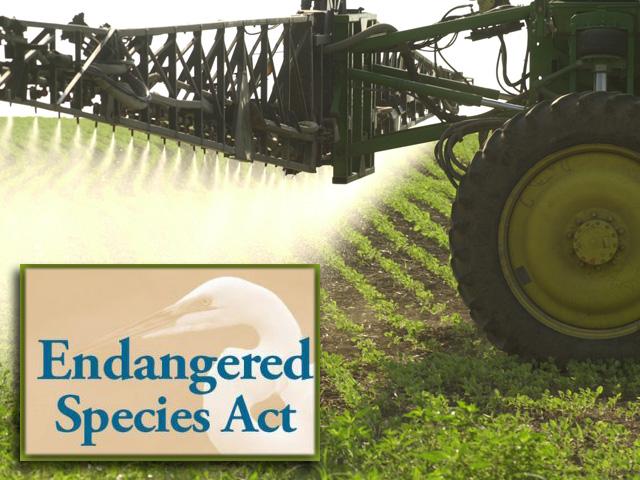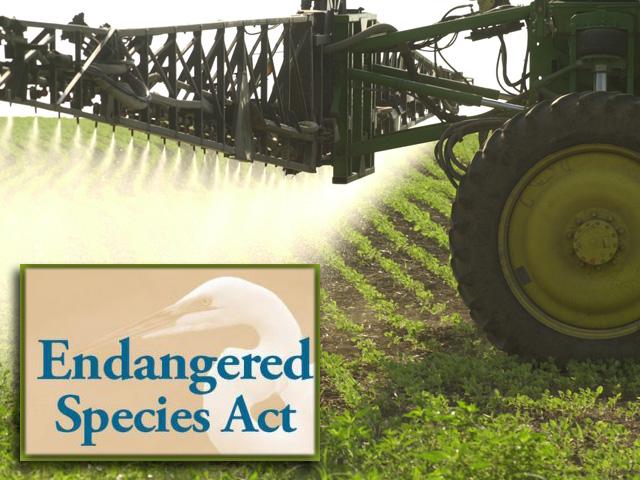Production Blog
What the Endangered Species Act Means for Ag Pesticide Use
ROCKVILLE, Md. (DTN) -- When Zack Rendel learned EPA's new labels for Enlist One and Enlist Duo banned use of the herbicides on his northeast Oklahoma farm, which was banking on planting Enlist soybeans this spring, he had a lot of words to describe the situation -- not all of them fit for publication.
But after EPA dropped its new endangered species policy that same day, a new phrase has emerged to describe the 2022 Enlist labels: A preview of things to come.
Based on DTN's analysis of this new EPA policy, farmers should expect to see more widespread, county-level prohibitions and increased run-off and spray drift restrictions on the labels of the pesticides they use in the future.
"I'm realizing this is probably the new normal," as Rendel put it. "And, well, it's just one more thing to worry about. It's very stressful for a young producer to operate when you don't know what they'll take away from you next."
So why is this happening? Essentially, for the first time in three decades, EPA has decided to fully comply with a federal statute called the Endangered Species Act.
"Reversing decades of practice, the U.S. Environmental Protection Agency (EPA) is taking meaningful action to further the Agency's compliance with the Endangered Species Act (ESA) when evaluating and registering new pesticide AIs [active ingredients]," the agency wrote in a news release on January 11. "Effective today, before EPA registers any new conventional AI, the Agency will evaluate the potential effects of the AI on federally threatened or endangered (listed) species, and their designated critical habitats..."
So what is the Endangered Species Act and what does this new policy mean for current and future pesticide registrations? Here's what we know so far.
EPA WILL ENFORCE THE ESA FULLY FOR THE FIRST TIME IN DECADES
As EPA openly noted in its announcement, the agency has never been fully in compliance with the Endangered Species Act, or ESA, which became federal law in 1973 -- just three short years after the EPA itself was founded by President Richard Nixon.
The ESA was designed to protect endangered and threatened species from extinction. Enforcing it falls to three federal agencies: the U.S. Fish and Wildlife Service, the National Marine Fisheries Service and the USDA.
But any federal agency whose actions could affect any of the roughly 1,800 listed species is required to ensure that those actions won't jeopardize the safety and health of those species or their habitats.
P[L1] D[0x0] M[300x250] OOP[F] ADUNIT[] T[]
For EPA, those "actions" are pesticide registrations.
"Before today's announcement, in most cases, EPA did not consistently assess the potential effects of conventional pesticides on listed species when registering new [active ingredient]s," the agency wrote. "This resulted in insufficient protections from new AIs for listed species, as well as resource-intensive litigation against EPA for registering new AIs prior to assessing potential effects on listed species."
Why EPA is suddenly pivoting to fully comply with the ESA is a complex question, but this "resource-intensive" litigation seems a primary driver. By not following federal law in this regard, EPA opened itself up to many lawsuits from environmental groups against its pesticide registrations. Now, if EPA can show it is complying with the ESA, it will be harder for groups to successfully sue them over pesticide registrations.
"EPA's new policy should reduce these types of cases against the Agency and improve the legal defensibility of new AIs, which often have lower human health and ecological risks than older pesticides," the agency stated in its release.
See the new policy announcement here: https://www.epa.gov/….
NEW LABEL RESTRICTIONS ARE LIKELY FOR MOST AG PESTICIDES
In order to comply with the ESA, EPA will conduct a process called a "biological evaluation" for every new pesticide registration. The biological evaluation assesses whether the pesticide and its application parameters are "likely to adversely affect" any listed species or habitats or not. The bar is very low for finding a "likely to adversely affect" ruling for a species, the agency has noted in the past. As a result, most of the pesticides that have gone through this process, such as glyphosate, atrazine and the neonicotinoids, are found "likely to adversely affect" the majority of listed species.
However, this doesn't automatically result in label changes. The EPA passes its biological evaluation conclusions on to "the Services" -- the U.S. Fish and Wildlife Service and the National Marine Fisheries Service. They examine the species, habitats and pesticides in question and deliver a "biological opinion" on whether the pesticide registration will cause "jeopardy" to a listed species or "adverse modification of" a critical habitat.
If it does, the Services propose "reasonable and prudent alternatives (RPAs)" -- measures to reduce that risk of jeopardy from the pesticide.
In a webinar held Jan. 13, employees from both the EPA and the Services stressed they work hard to find mitigations that will avoid that "jeopardy" designation for a pesticide registration. "The goal is not to have [a finding of] jeopardy, the goal is to avoid jeopardy," as Kristina Garber, a senior science adviser in the Environmental Fate and Effects Division of EPA, put it. "And so, a big tool to do that is mitigations. That might be minimizing spray drift or runoff."
While the Services and EPA are still actively researching and soliciting the best mitigation measures to protect listed species, two main ones are emerging -- either removing a region with listed species in it from the pesticide label, or adding spray drift or runoff mitigation requirements to minimize the species' exposure to the pesticide.
The new EPA labels for Enlist One and Enlist Duo are good templates for farmers to study and get used to. EPA states that the agency conducted the necessary endangered species analysis to comply with the ESA for these herbicides and now their labels include both county-level bans and new measures designed to limit runoff, such as limiting spraying 48 hours before a rain or when soils are saturated.
See more on those labels here: https://www.dtnpf.com/… and here: https://www.dtnpf.com/….
NEXT UP: GLYPHOSATE, ATRAZINE, NEONICOTINOIDS AND MORE
Beyond the Enlist herbicides, only a handful of pesticides -- malathion, 1,3-D (Telone), metolachlor, bromoxynil and prometryn -- have made it through the full process, from biological evaluation to completed biological opinions, with proposed mitigation measures.
You can see those biological opinions, some of which are finalized and some still in draft form, here: https://www.epa.gov/….
More are coming. EPA has already conducted biological evaluations on common ag pesticides, including finalized evaluations of glyphosate, atrazine and simazine. They are now in the hands of the Services, which will issue biological opinions on them in the coming months. See more on those finalized evaluations here: https://www.dtnpf.com/….
EPA has also released draft biological evaluations of three neonicotinoids, commonly used in row-crop seed treatments -- clothianidin (such as Poncho), imidacloprid (such as Gaucho) and thiamethoxam (such as Cruiser). The agency expects to finalize those evaluations in the summer of 2022, after which they will move to the Services for biological opinions. See more on those draft evaluations here: https://www.dtnpf.com/….
Ultimately, every pesticide that goes through the re-registration process, will be evaluated for its endangered species risks. That includes herbicides such as dicamba and 2,4-D, which are starting their rolling, 15-year re-registration processes in 2022, and will affect all products containing those active ingredients.
Non-synthetic pesticides, called bio-pesticides, won't necessarily be exempt, either, EPA said. "EPA is also continuing to explore applying these new ESA approaches to new biopesticide AIs and new antimicrobial AIs," the agency wrote in its announcement.
See the full schedule of pesticide re-registrations here: https://www.epa.gov/…
Emily Unglesbee can be reached at Emily.unglesbee@dtn.com.
Follow her on Twitter @Emily_Unglesbee
(c) Copyright 2022 DTN, LLC. All rights reserved.






Comments
To comment, please Log In or Join our Community .